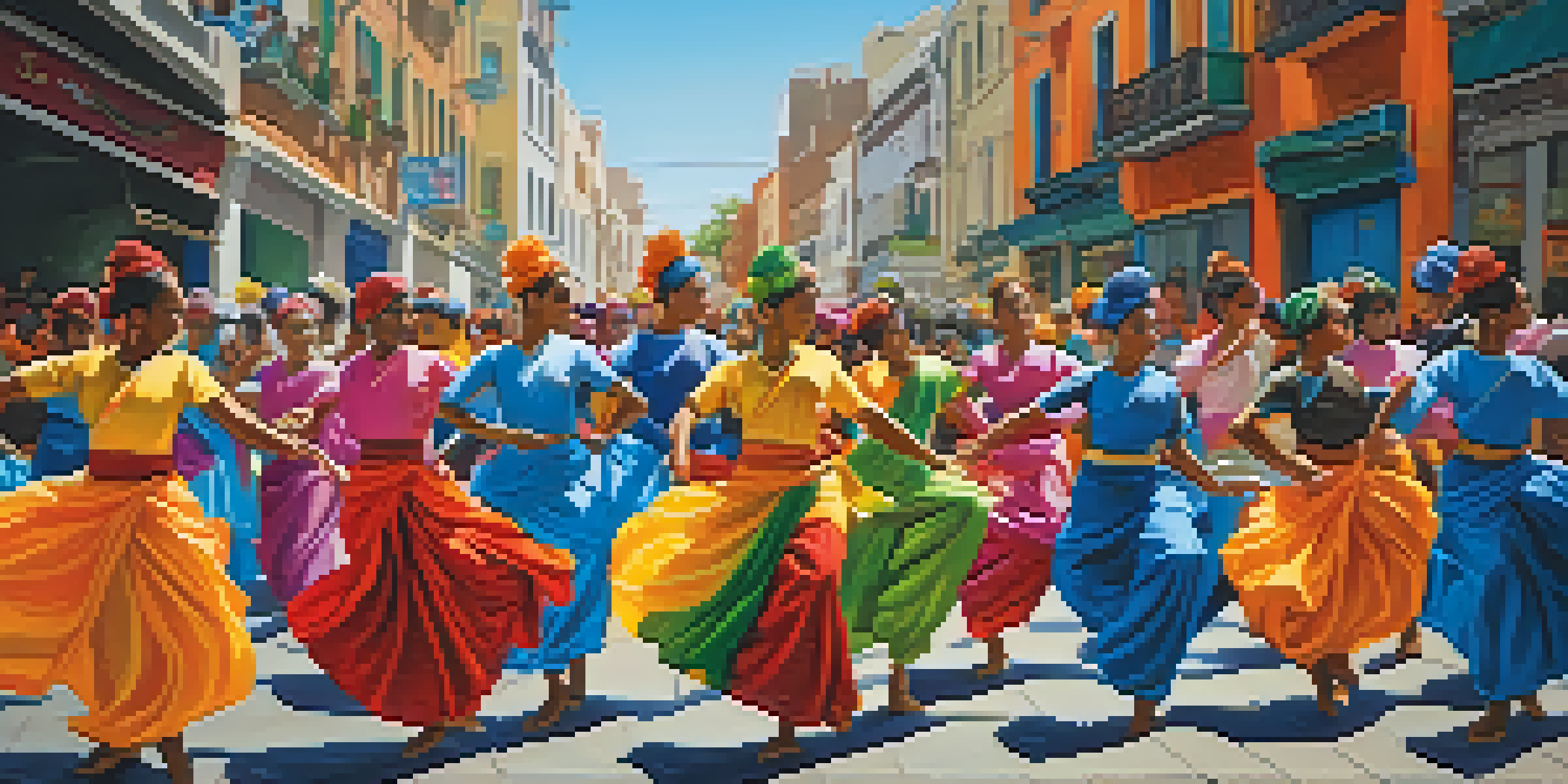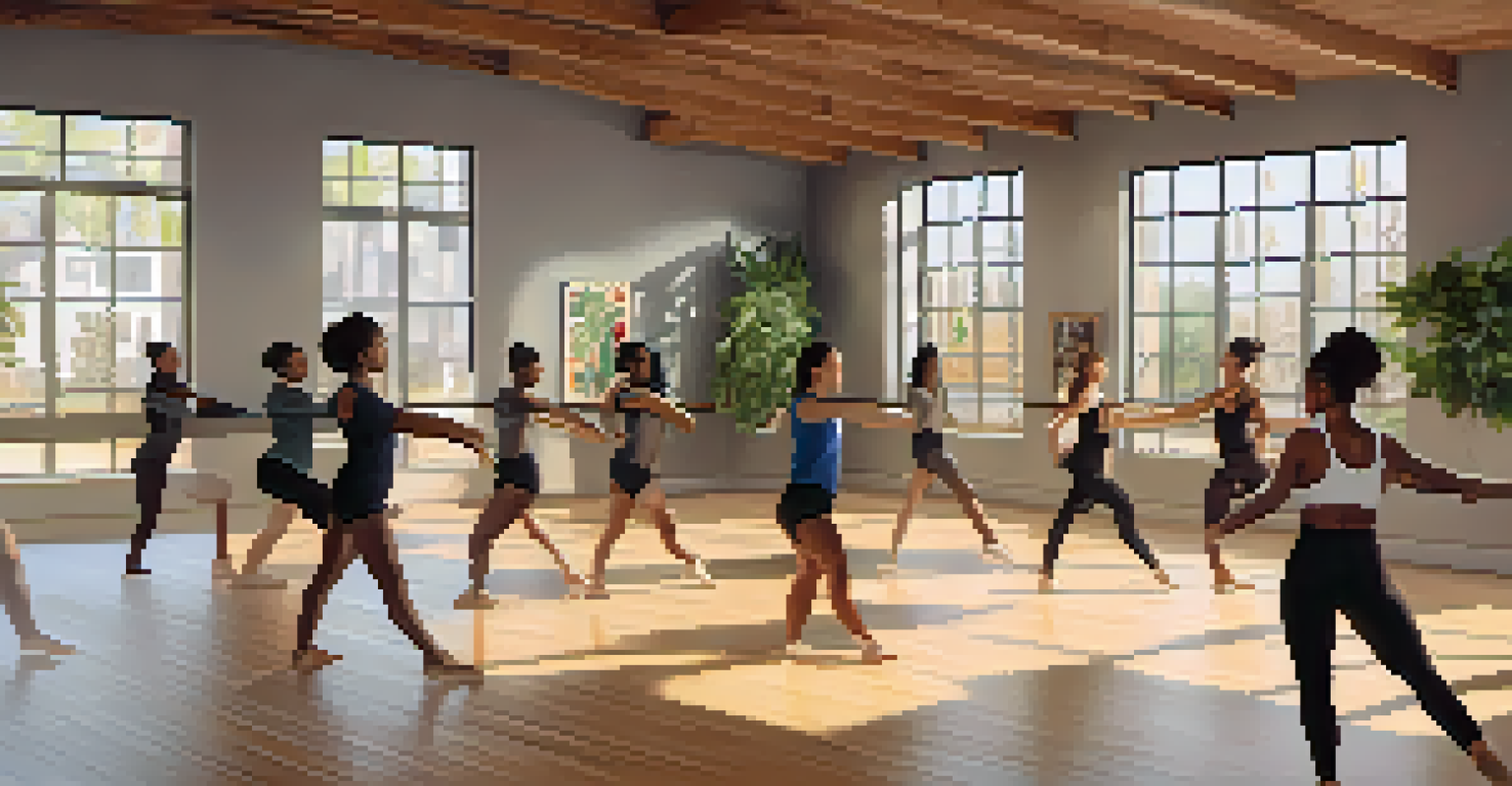Social Media and Cross-Cultural Dance Trends Today

The Rise of Social Media in Dance Culture
In recent years, social media platforms like TikTok and Instagram have revolutionized the way we discover and engage with dance. These platforms allow dancers from all over the world to showcase their talent, making dance accessible to a global audience. As a result, traditional dance forms are being blended with contemporary styles, creating an exciting fusion that reflects our interconnected world.
Dance is the hidden language of the soul.
Social media has also enabled dancers to connect and collaborate across cultural boundaries. A dancer in Brazil can easily partner with someone in Japan, sharing their unique styles and techniques. This cross-pollination fosters creativity and innovation, allowing new dance trends to emerge that might not have been possible in a more isolated setting.
Moreover, the viral nature of social media means that a dance challenge or trend can spread like wildfire. A single catchy beat or captivating choreography can inspire millions to join in, transcending geographic and cultural barriers. This phenomenon exemplifies how social media serves not just as a platform for sharing but as a catalyst for cultural exchange.
How Cross-Cultural Influences Shape Dance Styles
Cross-cultural influences are at the heart of many modern dance styles today. For instance, hip-hop has incorporated elements from traditional African dance, while Bollywood is infusing Western pop styles into its choreography. This blending of genres creates a rich tapestry of movement that celebrates the diversity of human expression.

Take the case of K-pop, which has gained immense popularity worldwide. Its choreography often merges traditional Korean dance with contemporary styles, creating a unique aesthetic that resonates with a global audience. This interplay allows dancers to explore their heritage while also embracing new influences, leading to innovative performances that captivate viewers.
Social Media Transforms Dance Culture
Platforms like TikTok and Instagram enable global dance collaboration and cultural exchange, blending traditional and contemporary styles.
These cultural exchanges are not limited to dance alone; they reflect broader societal trends of globalization. As people engage with various cultures through travel or online platforms, they bring back new ideas, which in turn inspires local dance communities. This symbiotic relationship between cultures enriches the dance landscape, making it more vibrant and dynamic.
The Role of Dance Challenges on Social Media
Dance challenges have become a defining feature of social media platforms, fostering a sense of community among users. These challenges often involve simple, catchy routines that anyone can learn and participate in, regardless of their dance background. This inclusivity encourages people to express themselves and share their moves, sparking a wave of creativity.
The dance is a poem of which each movement is a word.
A prime example is the 'Renegade' dance, which took TikTok by storm. Originating from a young dancer's creation, it quickly became a global phenomenon, with users of all ages and backgrounds joining in. This not only highlights the power of social media in amplifying individual talent but also demonstrates how a single dance can unite people from diverse cultures.
Moreover, these challenges often carry cultural significance, helping to introduce users to new dance styles and traditions. When participants learn and perform a dance rooted in a specific culture, they are, in a way, honoring that heritage while also putting their unique spin on it. This creates a dialogue between cultures, emphasizing the importance of understanding and appreciation.
Challenges of Cultural Appropriation in Dance
While social media promotes cross-cultural dance trends, it also raises concerns about cultural appropriation. This occurs when elements of a culture are used outside their original context, often without proper understanding or respect for their significance. For dancers, this can lead to a fine line between appreciation and exploitation.
For example, when a popular dance trend borrows heavily from a specific cultural practice without acknowledgment, it can diminish the value of that culture's traditions. This is particularly sensitive for marginalized communities whose art forms have been historically underrepresented. As a result, conversations around cultural sensitivity have become increasingly important in the dance community.
Cultural Sensitivity in Dance
While embracing diverse influences, it is crucial for dancers to educate themselves on cultural roots to avoid appropriation and promote respect.
To navigate these challenges, it's essential for dancers and choreographers to educate themselves about the cultural roots of the styles they wish to incorporate. Engaging with cultural representatives and respecting the history behind movements can foster a more authentic and respectful exchange. By doing so, the dance community can celebrate diversity while honoring the traditions that inspire them.
The Influence of Online Tutorials on Dance Learning
Online tutorials have transformed the way people learn dance, making it more accessible than ever. Platforms like YouTube and TikTok host countless dance tutorials, allowing anyone with internet access to learn new moves from the comfort of their home. This democratization of dance education empowers individuals to embrace their creativity and explore various styles.
The beauty of online tutorials is their ability to break down complex choreography into manageable steps. Dancers can pause, rewind, and practice at their own pace, which is especially beneficial for beginners. This flexibility not only boosts confidence but also encourages consistent practice, leading to improved skills over time.
Furthermore, the rise of online dance challenges often coincides with these tutorials, creating a sense of community among learners. As dancers share their progress and interpretations of popular routines, they inspire others to join in. This collaborative spirit fosters a supportive environment, where dancers can celebrate their achievements together, regardless of their cultural backgrounds.
The Future of Dance Trends in a Globalized World
Looking ahead, the future of dance trends will likely continue to be shaped by globalization and technological advancements. As virtual reality and augmented reality technologies become more mainstream, we may see new ways for dancers to connect and collaborate across distances. Imagine participating in a virtual dance class with instructors from around the world, all from your living room.
Additionally, social media will remain a powerful tool for sharing and discovering diverse dance styles. As platforms evolve, they will likely introduce new features that make dancing even more interactive and engaging. This ongoing innovation will encourage dancers to push boundaries and explore fresh creative avenues.
Online Tutorials Enhance Learning
The rise of online dance tutorials has democratized dance education, allowing individuals to learn at their own pace and fostering a supportive community.
Ultimately, the future of dance is bright and full of possibilities. By embracing cultural exchange and leveraging technology, the dance community can continue to celebrate its rich diversity. As we move forward, fostering respect and understanding between cultures will be key to ensuring that dance remains a unifying force in our increasingly interconnected world.
Conclusion: Celebrating Diversity Through Dance
In conclusion, social media has transformed the landscape of cross-cultural dance trends, creating opportunities for creative expression and cultural exchange. The blending of diverse styles not only enriches the dance community but also fosters a sense of unity among individuals from different backgrounds. As we navigate the complexities of cultural appreciation and appropriation, it's essential to approach dance with respect and curiosity.
By engaging with various dance forms and understanding their cultural significance, we can celebrate the rich tapestry of human expression. This journey is not just about mastering new moves; it’s about connecting with others and honoring the stories behind those movements. Social media serves as a powerful platform for these connections, amplifying voices and traditions that deserve to be heard.

As we dance our way into the future, let's continue to embrace the beauty of diversity. Whether through viral challenges or local dance gatherings, every step we take can contribute to a more inclusive and understanding world. After all, dance is a universal language that transcends borders, inviting us all to join in the celebration.